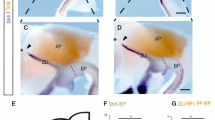Abstract
Segmentation of the paraxial mesoderm leads to somite formation. The underlying molecular mechanisms involve the oscillation of ”clock-genes” like c-hairy-1 and lunatic fringe indicative of an implication of the Notch signaling pathway. The cranio-caudal polarity of each segment is already established in the cranial part of the segmental plate and accompanied by the expression of genes like Delta1, Mesp1, Mesp2, Uncx-1, and EphA4 which are restricted to one half of the prospective somite. Dorsoventral compartmentalization of somites leads to the development of the dermomyotome and the sclerotome, the latter forming as a consequence of an epithelio-to-mesenchymal transition of the ventral part of the somite. The sclerotome cells express Pax-1 and Pax-9, which are induced by notochordal signals mediated by sonic hedgehog (Shh) and noggin. The craniocaudal somite compartmentalization that becomes visible in the sclerotomes is the prerequisite for the segmental pattern of the peripheral nervous system and the formation of the vertebrae and ribs, whose boundaries are shifted half a segment compared to the sclerotome boundaries. Sclerotome development is characterized by the formation of three subcompartments giving rise to different parts of the axial skeleton and ribs. The lateral sclerotome gives rise to the laminae and pedicles of the neural arches and to the ribs. Its development depends on signals from the notochord and the myotome. The ventral sclerotome giving rise to the vertebral bodies and intervertebral discs is made up of Pax-1 expressing cells that have invaded the perinotochordal space. The dorsal sclerotome is formed by cells that migrate from the dorso-medial angle of the sclerotome into the space between the roof plate of the neural tube and the dermis. These cells express the genes Msx1 and Msx2, which are induced by BMP-4 secreted from the roof plate, and they later form the dorsal part of the neural arch and the spinous process. The formation of the ventral and dorsal sclerotome requires directed migration of sclerotome cells. The regionalization of the paraxial mesoderm occurs by a combination of functionally Hox genes, the Hox code, and determines the segment identity. The development of the vertebral column is a consequence of a segment-specific balance between proliferation, apoptosis and differentiation of cells.
Similar content being viewed by others
Author information
Authors and Affiliations
Additional information
Accepted: 25 May 2000
Rights and permissions
About this article
Cite this article
Christ, B., Huang, R. & Wilting, J. The development of the avian vertebral column. Anat Embryol 202, 179–194 (2000). https://doi.org/10.1007/s004290000114
Issue Date:
DOI: https://doi.org/10.1007/s004290000114




